Group A
 South Africa (RSA)
South Africa (RSA)
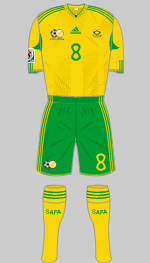
First
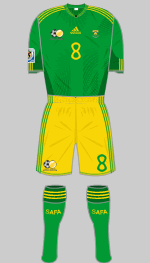
Second
Designer: Adidas
 The South African team (known as Bafana Bafana) faced a difficult task to qualify from a tough group containing three experienced World Cup teams. On paper they were the weakest of the African sides competing in the finals but they could count on passionate (and noisy) home support.
The South African team (known as Bafana Bafana) faced a difficult task to qualify from a tough group containing three experienced World Cup teams. On paper they were the weakest of the African sides competing in the finals but they could count on passionate (and noisy) home support.
The new "sunshine and twilight green" home kit introduced for 2010 is on the face of it straightforward but closer examination reveals an intricate jacquard pattern woven into the body (representing the national flag) and neat embroidery at the collar and hem of the shorts. The second choice strip is basically a reversal of the "home" kit with the addition of "forest green" trim on the shirts and socks.
 Mexico (MEX)
Mexico (MEX)
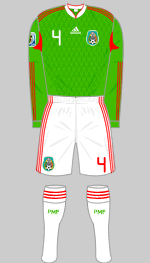
First
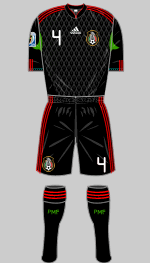
Second
Designer: Adidas
 Mexico appeared in their fifth consecutive World Cup Finals tournament, their fourteenth in all (more than any other team from the CONCACEF zone). The team initially struggled in the early qualifying games under their coach Sven Goran Erikssen but after he was replaced by former Atletico Madrid coach, Javier Aguirre, they began to play with greater consistency, finishing second in the final qualifying stage behind the USA.
Mexico appeared in their fifth consecutive World Cup Finals tournament, their fourteenth in all (more than any other team from the CONCACEF zone). The team initially struggled in the early qualifying games under their coach Sven Goran Erikssen but after he was replaced by former Atletico Madrid coach, Javier Aguirre, they began to play with greater consistency, finishing second in the final qualifying stage behind the USA.
El Tri played in their traditional green shirts and white shorts with red trimmings and chose black as their alternate strip.
(Julio Lopez)
 Uruguay (URU)
Uruguay (URU)
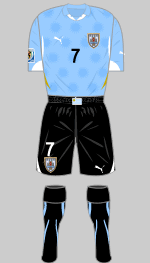
First
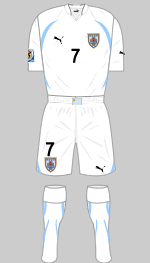
Second
Designer: Puma
 Uruguay hosted the first ever World Cup in 1930 and have won it twice, in 1930 and again in 1950. Prior to this they won gold medals in the 1924 and 1928 summer Olympics, which is why four stars appear above the team crest. More recently, La Celeste have struggled and this is only the second time they have reached the finals out of the last five competitions.
Uruguay hosted the first ever World Cup in 1930 and have won it twice, in 1930 and again in 1950. Prior to this they won gold medals in the 1924 and 1928 summer Olympics, which is why four stars appear above the team crest. More recently, La Celeste have struggled and this is only the second time they have reached the finals out of the last five competitions.
The teams traditional colours are sky blue and black. Their Puma strip featured a multi-pointed sun motif from the national flag embossed into the fabric. Early reports that the second choice shirts would be metallic gold appear to be incorrect while the early releases of the home shirt had a red Puma logo.
 France (FRA)
France (FRA)
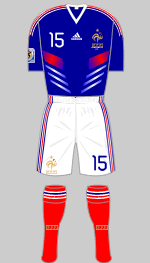
First
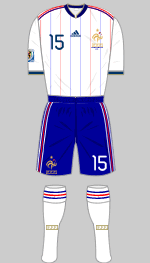
Second
Designer: Adidas
 France's qualification was marred by the circumstances of the decisive play-off game against the Republic of Ireland, which was settled after Thierry Henry handled the ball on the goal line before passing to William Gallas who scored. The resulting outcry severely damaged the reputation of Henry and of the sport in general.
France's qualification was marred by the circumstances of the decisive play-off game against the Republic of Ireland, which was settled after Thierry Henry handled the ball on the goal line before passing to William Gallas who scored. The resulting outcry severely damaged the reputation of Henry and of the sport in general.
Les Blues won the World Cup in 1998 and were beaten finalists last time out. Their new strip is a reinterpret ion of the classic 1984 shirt, worn when the team won the European Championship. The classic white change shirt with fine red and blue pinstripes reappears as second choice, embellished with navy and metallic gold trim at collar and cuffs.
(Julio Lopez)
Group B
 Argentina (ARG)
Argentina (ARG)
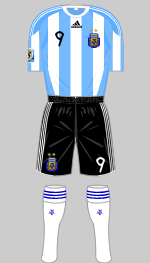
First
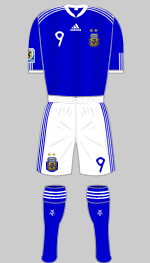
Second
Designer: Adidas
 Argentina made extremely heavy weather of qualifying, due in no small part to the eccentric selection policy of Diego Maradona, now national team coach, who picked no fewer than 56 players in 2009 alone. Nevertheless Los Albicelestes (sky blue and whites) are considered serious contenders to add a third World Cup to their tally.
Argentina made extremely heavy weather of qualifying, due in no small part to the eccentric selection policy of Diego Maradona, now national team coach, who picked no fewer than 56 players in 2009 alone. Nevertheless Los Albicelestes (sky blue and whites) are considered serious contenders to add a third World Cup to their tally.
The stripes on the new Adidas shirt are officially described as "Colombian Blue". The change strip is, as usual, royal blue (although no doubt Adidas' marketing people have come up with a more fanciful description) and white and for 2010 features a shadow stripe on the shirts.
 Nigeria (NGA)
Nigeria (NGA)
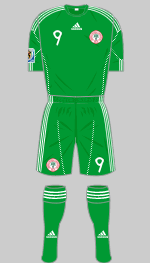
First
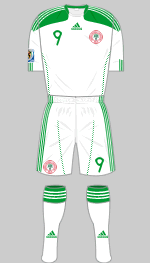
Second
Designer: Adidas
 It was rumoured at the end of 2009 that the Nigerian Football Federation had rejected Adidas' new design. This turned out to be untrue as the twilight green strip were made available to the replica kit market at the beginning of 2010. The Eagles finished third in the 2010 African Cup of Nations and were taking part in their fourth World Cup finals campaign.
It was rumoured at the end of 2009 that the Nigerian Football Federation had rejected Adidas' new design. This turned out to be untrue as the twilight green strip were made available to the replica kit market at the beginning of 2010. The Eagles finished third in the 2010 African Cup of Nations and were taking part in their fourth World Cup finals campaign.
(Dale Hammerly)
 Korea Republic (KOR)
Korea Republic (KOR)
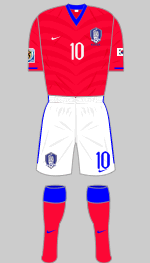
First
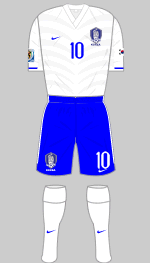
Second
Designer: Nike
 Usually known as South Korea, the team was taking part in the World Cup finals for the eighth time, more than any other Asian side. They are known as the Taeguk Warriors and generally play in pinkish red shirts with a change kit in white and blue. Both have a jacquard print woven into the shirt.
Usually known as South Korea, the team was taking part in the World Cup finals for the eighth time, more than any other Asian side. They are known as the Taeguk Warriors and generally play in pinkish red shirts with a change kit in white and blue. Both have a jacquard print woven into the shirt.
 Greece (GRE)
Greece (GRE)
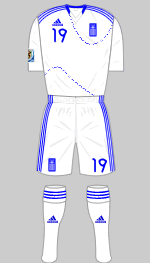
First
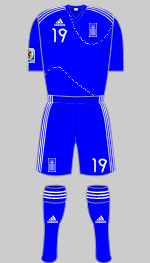
Second
Designer: Adidas
 This is only the second time that Greece have reached the World Cup Finals. Remarkably in their previous appearance, in 1994, they were also drawn in the same group as Argentina and Nigeria.
This is only the second time that Greece have reached the World Cup Finals. Remarkably in their previous appearance, in 1994, they were also drawn in the same group as Argentina and Nigeria.
Greece have traditionally played in blue but after they became surprise winners of Euro 2004, they have worn all-white, the colours worn in the final of that competition, retaining all-blue as their second choice.
Group C
 England (ENG)
England (ENG)
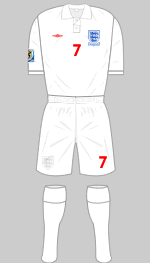
First
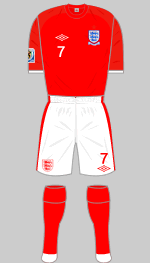
Second
Designer: Umbro
 With Fabio Capello in charge, England were a team transformed and qualified with some ease, losing just one game.
With Fabio Capello in charge, England were a team transformed and qualified with some ease, losing just one game.
The all-white strip introduced in 2009 not only recalls the 1970 World Cup finals but also the original colours worn when the first international fixtures were played in the 1870s. The red and white away strip deliberately evokes the 1966 World Cup final.
 United States of America (USA)
United States of America (USA)
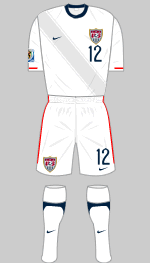
First
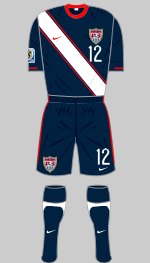
Second
Designer: Nike
 Having finished as runners-up in the 2009 Confederations Cup (the rehearsal for the World Cup played in South Africa) and qualified with some ease, the Stars and Stripes were in their sixth consecutive World Cup Finals.
Having finished as runners-up in the 2009 Confederations Cup (the rehearsal for the World Cup played in South Africa) and qualified with some ease, the Stars and Stripes were in their sixth consecutive World Cup Finals.
The decision to wear a sash was almost certainly inspired by the strip worn in the historic 1-0 win the United States team achieved against England in the 1950 World Cup finals.
The home strip appeared at the end of April and is white with a silver sash. The main colour of the second choice kit is described as "obsidian," a shade familiar to Arsenal supporters.
 Algeria (ALG)
Algeria (ALG)
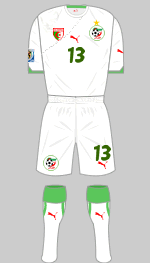
First
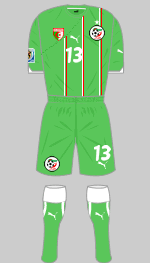
Second
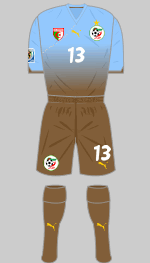
Third
Designer: Puma
 This was the third time that Algeria have qualified for the finals and marks the end of a barren 20-year spell since Algeria won the African Cup of Nations in 1990.
This was the third time that Algeria have qualified for the finals and marks the end of a barren 20-year spell since Algeria won the African Cup of Nations in 1990.
Algeria wear Puma's new Africa range, launched in advance of the African Cup of Nations and worn exclusively by African teams. The all-white first choice strip has an image of a desert fox printed into the fabric below the right shoulder (the team are known as Les Fennecs).
 Slovenia (SVN)
Slovenia (SVN)
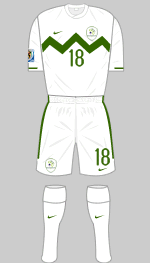
First
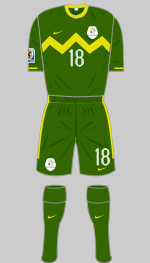
Second
Designer: Nike
 The Slovenian FA was formed in 1991 after the country broke away from Yugoslavia and their team appears in the World Cup Finals for the second time.
The Slovenian FA was formed in 1991 after the country broke away from Yugoslavia and their team appears in the World Cup Finals for the second time.
The team normally wear white with dark green trim. Their new strips featured a jagged band across the chest that represents Mount Triglav (Three Heads Mountain), the highest peak in the country. The lime green that features on the emblem of the FA of Slovenia and in the second choice strip represents the lipa (lime tree), a national emblem.
(Graham Brack)
Group D
 Germany (GER)
Germany (GER)
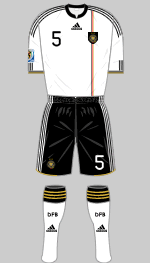
First
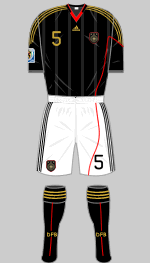
Second
Designer: Adidas
 The formidable Germans have reached the World Cup final seven times, a record shared with Brazil, and have been champions three times (FIFA considers the West German team that competed between 1950-1990 as a continuation of the united Germany team).
The formidable Germans have reached the World Cup final seven times, a record shared with Brazil, and have been champions three times (FIFA considers the West German team that competed between 1950-1990 as a continuation of the united Germany team).
As usual Adidas have designed a stylish variation on the traditional white shirts and black shorts, featuring a pair of narrow vertical stripes in red and gold on the left side of the chest and metallic gold trim on the socks. The crest of the Deutscher Fußball-Bund also appears in gold against a black background.
The black second choice shirts may strike many as an unhappy choice: they are based on the colours worn when a German select XI played an unofficial international in Paris in 1898.
 Australia (AUS)
Australia (AUS)
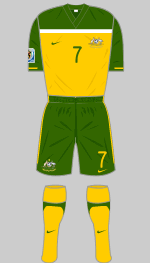
First
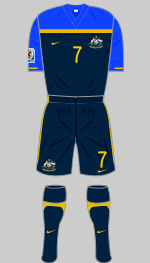
Second
Designer: Nike
 Australia switched from the Oceania Football Confederation in January 2006 to become invitee members of the ASEAN Football Federation in a bid to raise standards and provide more competitive fixtures. The Socceroos have appeared in two previous finals (1974 and 2006).
Australia switched from the Oceania Football Confederation in January 2006 to become invitee members of the ASEAN Football Federation in a bid to raise standards and provide more competitive fixtures. The Socceroos have appeared in two previous finals (1974 and 2006).
The team play in the gold and dark green associated with all Australian sport at national level. The second choice was unveiled earlier and provides a total contrast, in "obsidian," mid-blue and gold.
 Serbia (SRB)
Serbia (SRB)
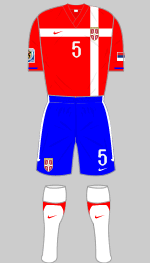
First
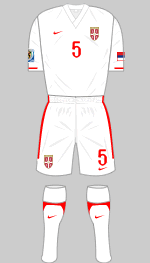
Second
Designer: Nike
 Serbia played their first international in August 2006, having previously formed part of the Serbia & Montenegro team and before that, Yugoslavia. This was, therefore, the first time a Serbian team had appeared in the World Cup finals as a separate entity.
Serbia played their first international in August 2006, having previously formed part of the Serbia & Montenegro team and before that, Yugoslavia. This was, therefore, the first time a Serbian team had appeared in the World Cup finals as a separate entity.
The team play in red, blue and white, reproducing the national flag and are known as Beli Orlovi (the White Eagles). Their change strip is all-white.
 Ghana (GHA)
Ghana (GHA)
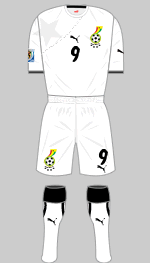
First
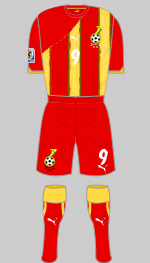
Second
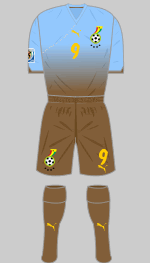
Third
Designer: Puma
 The Black Stars have appeared just once in previous World Cup finals (2006) but have won the African Cup of Nations four times, making them second only to Egypt in that competition. Indeed they met Egypt in this year's final, losing 0-1.
The Black Stars have appeared just once in previous World Cup finals (2006) but have won the African Cup of Nations four times, making them second only to Egypt in that competition. Indeed they met Egypt in this year's final, losing 0-1.
The team play in all-white, now in Puma's latest Africa range, with the black star from the national flag as a jacquard print on the right shoulder. The second choice strip is in deep red with fine gold and green stripes, printed to achieve a ragged, painted appearance.
Group E
 Netherlands (NED)
Netherlands (NED)
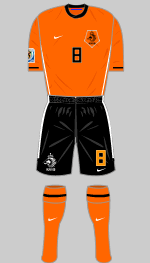
First
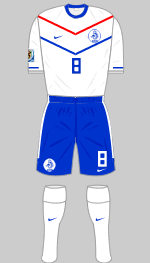
Second
Designer: Nike
 Frequently (but incorrectly) referred to as "Holland," the Dutch team are associated with the brilliant Total Football side, led by Johan Cruyff in the 1970s when they reached two World Cup finals. Although they have remained a strong team ever since (they are ranked third in the world by FIFA at the time of writing), their only success has been a European Championship in 1988.
Frequently (but incorrectly) referred to as "Holland," the Dutch team are associated with the brilliant Total Football side, led by Johan Cruyff in the 1970s when they reached two World Cup finals. Although they have remained a strong team ever since (they are ranked third in the world by FIFA at the time of writing), their only success has been a European Championship in 1988.
The new Dutch home strip was launched in April 2010. The new "away" kit features striking chevrons (repeated on the back of the socks) in the national colours.
 Denmark (DEN)
Denmark (DEN)
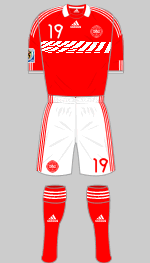
First
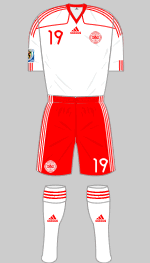
Second
Designer: Adidas
 Winners of Euro 92, the Danes have been present in only two of the four World Cup final staged since then. Their traveling fans are called roligans, known for their peaceful but passionate support (rolig = calm).
Winners of Euro 92, the Danes have been present in only two of the four World Cup final staged since then. Their traveling fans are called roligans, known for their peaceful but passionate support (rolig = calm).
Danish teams play in the national colours of red and white, currently with an intricate white band across the chest on the first choice strip. This is absent from the second strip, which has, as usual, the colours reversed. The shorts and socks are interchangeable.
(Mark Felix-Johnson)
 Japan (JPN)
Japan (JPN)
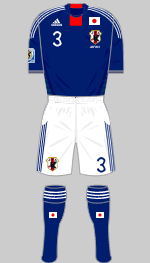
First
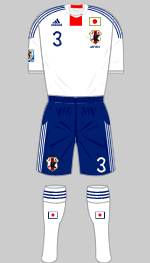
Second
Designer: Adidas
 Japan are currently one of the leading teams in Asia, having won the Asian Cup three times and qualifying four the last four World Cup finals. They have no official nickname but are sometimes referred to, rather lugubriously, as Soccer Nippon Daihyō (Japanese representatives of soccer). More recently the term Samurai Blue has come into common use.
Japan are currently one of the leading teams in Asia, having won the Asian Cup three times and qualifying four the last four World Cup finals. They have no official nickname but are sometimes referred to, rather lugubriously, as Soccer Nippon Daihyō (Japanese representatives of soccer). More recently the term Samurai Blue has come into common use.
The team's first choice strip is in traditional deep blue with a red block at the collar. The national flag appears above the crest of the Japan Football Association. The second choice simply reverses the theme so all elements can be interchanged.
 Cameroon (CMR)
Cameroon (CMR)
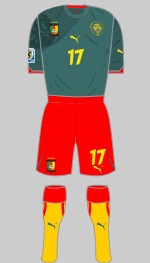
First
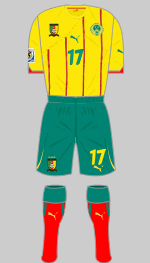
Second
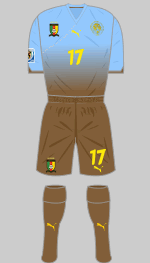
Third
Designer: Puma
 The exploits of the Cameroon team in the 1982 and 1990 World Cup finals served notice that African teams could challenge the leading sides from South America and Europe, paving the way for an increase from two to three African qualifiers. Les Lions Indomptables (The Indomitable Lions) have appeared regularly in the finals ever since (although they missed out on the 2006 tournament) and have won the African Cup of Nations four times.
The exploits of the Cameroon team in the 1982 and 1990 World Cup finals served notice that African teams could challenge the leading sides from South America and Europe, paving the way for an increase from two to three African qualifiers. Les Lions Indomptables (The Indomitable Lions) have appeared regularly in the finals ever since (although they missed out on the 2006 tournament) and have won the African Cup of Nations four times.
Cameroon have in the past fallen foul of FIFA with sleeveless and one-piece playing kits but their new Puma African strips avoid further controversy. The lion motif appears as an additional crest and as a jacquard print on the green first choice shirts while interesting paint-effect" stripes decorate the yellow second-choice top. The team habitually switch their shorts and socks to avoid clashes with opponents.
Group F
 Italy (ITA)
Italy (ITA)
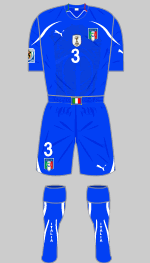
First
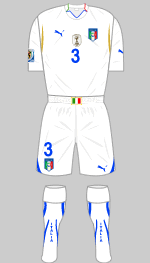
Second
Designer: Puma
 Italy are holders of the FIFA World Cup and have won the competition four times, making them second only to Brazil in the history of the competition. They team are known as Azzuri after the colour of their shirts, which are taken from the colours of the Royal House of Savoy under whom Italy was unified in 1861.
Italy are holders of the FIFA World Cup and have won the competition four times, making them second only to Brazil in the history of the competition. They team are known as Azzuri after the colour of their shirts, which are taken from the colours of the Royal House of Savoy under whom Italy was unified in 1861.
The Italians can usually be relied upon to wear stylish outfits and the sets unveiled for 2010 are no exception. The first choice strip is in traditional azzuri blue, a shade lighter than usual and features a dramatic jacquard print on the front and back of the shirt. Although traditionally Italy wear white shorts, they have opted for blue this year, which is what they wore when they won in 2006.
 Paraguay (PAR)
Paraguay (PAR)
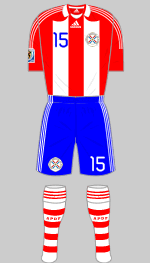
First
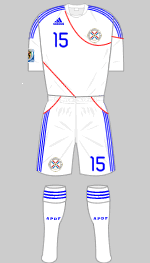
Second
Designer: Adidas
 This is the eighth time that Paraguay have reached the final stage of the World Cup. They appear to have made considerable progress in recent years, becoming the second team to qualify from the CONMEBOL zone, ahead of Argentina, Colombia and Chile.
This is the eighth time that Paraguay have reached the final stage of the World Cup. They appear to have made considerable progress in recent years, becoming the second team to qualify from the CONMEBOL zone, ahead of Argentina, Colombia and Chile.
Paraguay's traditional colours are red and white striped shirts and blue shorts, taken directly from the national flag.
(Graeme Mason)
 New Zealand (NZL)
New Zealand (NZL)
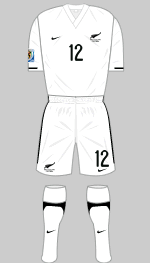
First
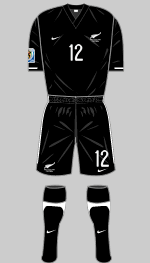
Second
Designer: Nike
 Despite having many amateur players, association football struggles for attention and resources against the two rugby codes in New Zealand. A semi-professional football league only started in 2004 and the country's single fully professional team plays in the Australian A League. Qualifying for the World Cup finals for the second time in their history is therefore something of an achievement.
Despite having many amateur players, association football struggles for attention and resources against the two rugby codes in New Zealand. A semi-professional football league only started in 2004 and the country's single fully professional team plays in the Australian A League. Qualifying for the World Cup finals for the second time in their history is therefore something of an achievement.
The team are known as the "All-Whites" to distinguish them from the illustrious national rugby union team and because that's what they play in. When a change is required the Kiwis turn out in black.
 Slovakia (SVK)
Slovakia (SVK)
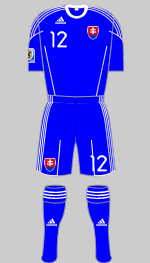
First
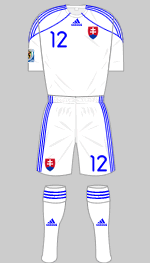
Second
Designer: Adidas
 The Slovakian team played its first international in February 1994 after the break up of the former Czechoslovakia. They appear in the World Cup finals for the first time in their history although the Czechoslovak team played in eight tournaments and reached the final twice. The team wear the national emblem rather than the badge of the Slovak Football Association.
The Slovakian team played its first international in February 1994 after the break up of the former Czechoslovakia. They appear in the World Cup finals for the first time in their history although the Czechoslovak team played in eight tournaments and reached the final twice. The team wear the national emblem rather than the badge of the Slovak Football Association.
(Bertie Wright)
Group G
 Brazil (BRA)
Brazil (BRA)
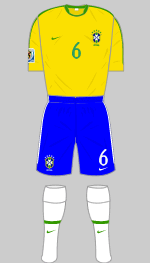
First
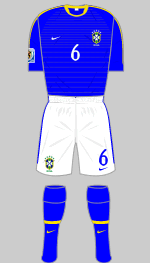
Second
Designer: Nike
 Brazil are, quite simply the most successful team in the history of the World Cup. Champions five times, they have appeared in every finals tournament. Although the team's green trimmed gold shirts, blue shorts and white socks have become iconic, they did not appear until March 1954 after the newspaper, Correio da Manhã, ran a competition to design a more patriotic strip to replace the all-blue outfit worn at the time.
Brazil are, quite simply the most successful team in the history of the World Cup. Champions five times, they have appeared in every finals tournament. Although the team's green trimmed gold shirts, blue shorts and white socks have become iconic, they did not appear until March 1954 after the newspaper, Correio da Manhã, ran a competition to design a more patriotic strip to replace the all-blue outfit worn at the time.
Nike have made only changes in the detailing of both first and second choice strips for 2010. The blue second strip has a pattern of fine dots over the body.
 Korea DPR (PRK)
Korea DPR (PRK)
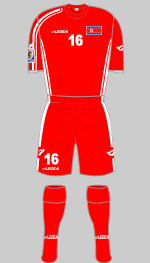
First
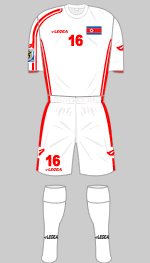
Second
Designer: Legea
 No-one old enough to remember the 1966 World Cup finals will ever forget the exploits of the diminutive North Korean team who beat Italy 1-0 to qualify for the quarter-finals where they went 3-0 up against Portugal before conceding five to lose the match.
No-one old enough to remember the 1966 World Cup finals will ever forget the exploits of the diminutive North Korean team who beat Italy 1-0 to qualify for the quarter-finals where they went 3-0 up against Portugal before conceding five to lose the match.
Although North and South Korea are still technically at war, the teams met in the qualifying competition. The first match was moved to Shanghai after the North Korean government refused to allow the South Korean flag to be flown or the anthem to be played in Pyongyang. After the DPRK team lost the return leg in Seoul their coach accused their opponents of poisoning his team.
The team plays in all-red but the commercial exploitation of replica kits is not a priority in the workers' paradise and in the few warm up matches they have played in strips by various manufacturers. Against Venezuela they had to borrow a set from the home team after their own were lost in transit. However, HFK has learned that their strips for the finals are supplied by Italian company, Legea.
 Côte d'Ivoire (CIV)
Côte d'Ivoire (CIV)
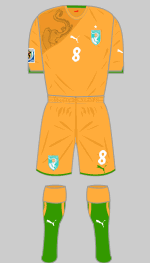
First
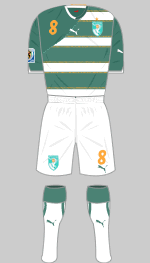
Second
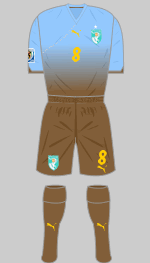
Third
Designer: Puma
Usually referred to as the Ivory Coast in English, Les Éléphants have made one previous appearance in the finals, in Germany 2006 when they came from two goals down to beat Serbia & Montenegro 3-2.
The team wear typically eye-catching Puma Africa strips derived from their national colours. The light orange first choice outfit features a jacquard print of an elephant's head while the second choice shirts feature the latest paint-streak effect.
 Portugal (POR)
Portugal (POR)
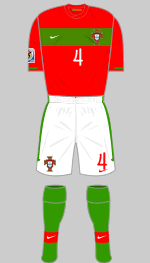
First
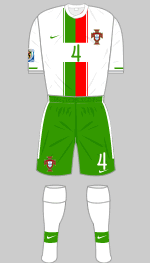
Second
Designer: Nike
 Despite having regularly produced brilliant footballers of the caliber of Eusebio and Luis Figo, the Portuguese national team has made a limited impact on the world stage. This is only the fifth time they have reached the finals although they finished third in 1966, fourth in 2006 and, of course they famously lost to Greece in the final of Euro 2004 played on their home territory.
Despite having regularly produced brilliant footballers of the caliber of Eusebio and Luis Figo, the Portuguese national team has made a limited impact on the world stage. This is only the fifth time they have reached the finals although they finished third in 1966, fourth in 2006 and, of course they famously lost to Greece in the final of Euro 2004 played on their home territory.
The second choice strip, which was unveiled first, features a striking broad vertical stripe in the national colours of red and green, reminiscent of Mexico's change strip from 1978. The home strip features an equally striking horizontal band in green with a very fine pattern of red dots.
Group H
 Spain (ESP)
Spain (ESP)
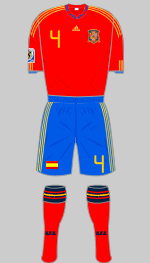
First
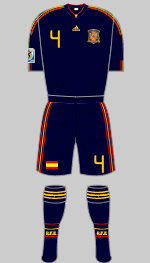
Second
Designer: Adidas
 The Spanish team have convincingly overcome their reputation as perpetual under-achievers by winning Euro 2008. They were undefeated in 35 matches between November 2006 and June 2009 (equalling Brazil's record) and are the only team never to have won the World Cup to top the FIFA international rankings (between July 2008 and June 2009).
The Spanish team have convincingly overcome their reputation as perpetual under-achievers by winning Euro 2008. They were undefeated in 35 matches between November 2006 and June 2009 (equalling Brazil's record) and are the only team never to have won the World Cup to top the FIFA international rankings (between July 2008 and June 2009).
Spain's new "home" strip consists of "collegiate red" shirts trimmed in gold and blue with bright blue shorts while the second choice is dark-blue, trimmed with the national colours.
 Switzerland (SUI)
Switzerland (SUI)
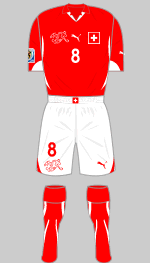
First
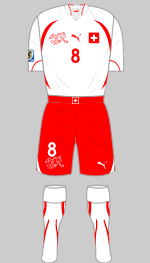
Second
Designer: Puma
 The Swiss team is making its ninth appearance but only the third since 1970. They have a modest record in the finals and have not got past the second round (or Round of 16) since 1954.
The Swiss team is making its ninth appearance but only the third since 1970. They have a modest record in the finals and have not got past the second round (or Round of 16) since 1954.
Their new strip is a variation of their traditional red shirts and white shorts in Puma's new template. The Swiss have taken advantage of FIFA regulations that permit a national emblem to appear on shirts as well as the logo of the Swiss Football Federation and makers' trademark. Replica shirts carry the logotype of the Credit Suisse bank (who sponsor the team) but sponsorship is not permitted in the World Cup finals.
The second strip more or less a reversed version of the first choice kit.
(Mark Felix-Johnson)
 Honduras (HON)
Honduras (HON)
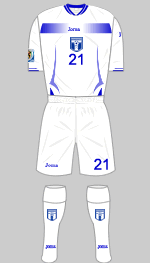
First
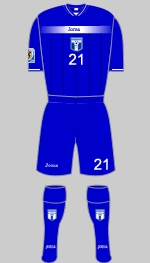
Second
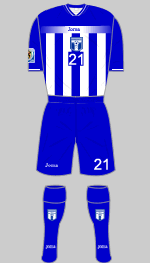
Third
Designer: Joma
Los Cotrachos have played in the World Cup finals just once before, in 1982 and clinched an automatic qualifying place in the final round of matches by virtue of a 1-0 win over El Salvador, finishing ahead of Costa Rica thanks to superior goal difference.
Honduras play in all-white and Joma have added an attractive band that fades from blue to white across the upper chest. This motif also appears on the second and third kits. The shorts and socks are interchangeable.
(Graeme Mason)
 Chile (CHI)
Chile (CHI)
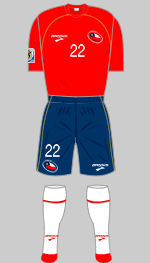
First
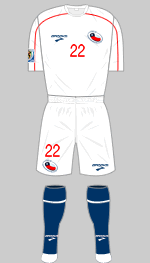
Second
Designer: Brooks Sports
 Chile's best performance in the World Cup was in 1962 when they hosted the finals and finished third. This is their fifth appearance since then. Their traditional colours of red shirts and blue shorts were established in 1947 and have been worn ever since.
Chile's best performance in the World Cup was in 1962 when they hosted the finals and finished third. This is their fifth appearance since then. Their traditional colours of red shirts and blue shorts were established in 1947 and have been worn ever since.
Chile's team is sponsored by the American sports and leisure wear manufacturer, Brooks.
(Graeme Mason)
Match by Match Sections -
Group A | Group B | Group C | Group D | Group E | Group F | Group G | Group H | Knock Out Stages
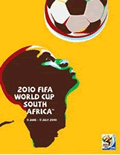 The 2010 World Cup, played between 11 June and 11 July, marked the first occasion that the finals have been played on the African continent. Only the host nation received an automatic place in the finals while Italy, world champions in 2006, had to negotiate their way through the qualifying competition.
The 2010 World Cup, played between 11 June and 11 July, marked the first occasion that the finals have been played on the African continent. Only the host nation received an automatic place in the finals while Italy, world champions in 2006, had to negotiate their way through the qualifying competition. South Africa (RSA)
South Africa (RSA)

 Mexico (MEX)
Mexico (MEX)

 Uruguay (URU)
Uruguay (URU)

 France (FRA)
France (FRA)

 Argentina (ARG)
Argentina (ARG)

 Nigeria (NGA)
Nigeria (NGA)

 Korea Republic (KOR)
Korea Republic (KOR)

 Greece (GRE)
Greece (GRE)

 England (ENG)
England (ENG)

 United States of America (USA)
United States of America (USA)

 Algeria (ALG)
Algeria (ALG)


 Slovenia (SVN)
Slovenia (SVN)

 Germany (GER)
Germany (GER)

 Australia (AUS)
Australia (AUS)

 Serbia (SRB)
Serbia (SRB)

 Ghana (GHA)
Ghana (GHA)


 Netherlands (NED)
Netherlands (NED)

 Denmark (DEN)
Denmark (DEN)

 Japan (JPN)
Japan (JPN)

 Cameroon (CMR)
Cameroon (CMR)


 Italy (ITA)
Italy (ITA)

 Paraguay (PAR)
Paraguay (PAR)

 New Zealand (NZL)
New Zealand (NZL)

 Slovakia (SVK)
Slovakia (SVK)

 Brazil (BRA)
Brazil (BRA)

 Korea DPR (PRK)
Korea DPR (PRK)

 Côte d'Ivoire (CIV)
Côte d'Ivoire (CIV)


 Portugal (POR)
Portugal (POR)

 Spain (ESP)
Spain (ESP)

 Switzerland (SUI)
Switzerland (SUI)

 Honduras (HON)
Honduras (HON)


 Chile (CHI)
Chile (CHI)
